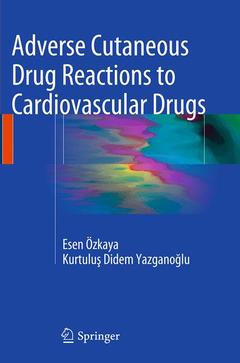Description
Adverse Cutaneous Drug Reactions to Cardiovascular Drugs, Softcover reprint of the original 1st ed. 2014
Authors: Özkaya Esen, Yazganoğlu Kurtuluş Didem
Language: English
Subjects for Adverse Cutaneous Drug Reactions to Cardiovascular Drugs:
126.59 €
In Print (Delivery period: 15 days).
Add to cartPublication date: 08-2016
Support: Print on demand
Approximative price 105.49 €
In Print (Delivery period: 15 days).
Add to cartPublication date: 12-2014
259 p. · 15.5x23.5 cm · Hardback
Description
/li>Contents
/li>Biography
/li>Comment
/li>
Esen ÖZKAYA: Professor of Dermatology in İstanbul University, İstanbul Medical Faculty, Department of Dermatology and Venereology. EDUCATIONAL AND ACADEMIC BACKGROUND Graduated with the first degree from German High School İstanbul in 1984 and from İstanbul Medical Faculty, İstanbul University in 1990. Resident of Dermatology in İstanbul University, İstanbul Medical Faculty, Department of Dermatology and Venereology (1990-1994). Scholarship resident in Department of Dermatology, WWU (Westfälische Wilhelms Universität) Münster, Germany (1992-1993). Specialist of Dermatology (1994-1998), Associate Professor of Dermatology (1998-2004), and Professor of Dermatology (since 2004) in İstanbul University, İstanbul Medical Faculty, Department of Dermatology and Venereology. ACADEMIC POSITION University teacher in İstanbul University, İstanbul Medical Faculty, Department of Dermatology and Venereology (since 1998). Founder of the Dermatoallergy unit in the Department of Dermatology and Venereology, İstanbul Medical Faculty in 1996. POSTGRADUATE EDUCATIONAL PROJECTS Head of the organizing committee and tutor of the postgraduate training courses of dermatoallergy tests for dermatologists in 2007 (DATK 2007) and in 2009 (DATK 2009) AWARDS German Academic Exchange Service-DAAD scholarship award (1992-1993). Istanbul University Science Award (2003). SCIENTIFIC PUBLICATIONS Approximately 70 publications in peer-reviewed international journals and many articles in national journals mainly on allergic contact dermatitis, adverse cutaneous drug reactions, atopic dermatitis, and urticaria. Author of an upcoming Turkish book on allergic skin diseases and diagnostic tests.
KURTULUŞ DİDEM YAZGANOĞLU: Associate Professor of Dermatology in İstanbul University, İstanbul Medical Faculty, Department of Dermatology and Venereology. EDUCATIONAL AND ACADEMIC BACKGROUND Graduation from Izmir Özel Türk College, Science High School in 1994 and from Ege University Medical Facu
Comprehensive review with color photos on skin side effects of cardiovascular drugs
Includes useful tables allowing diagnosis according to drug class and the type of dermatologic reaction at a glance
Special emphasis on cross-reactions and the role of patch testing in diagnosis
Easy access and common use in dermatology outpatient clinics
These books may interest you

Adverse Cutaneous Drug Eruptions 219.95 €



